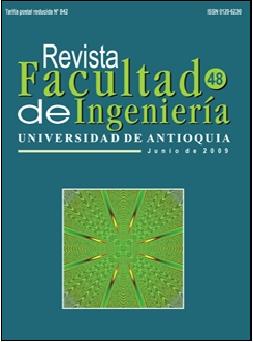A sampling plan for residentially generated solid waste quantification at urban zones of middle sized cities
DOI:
https://doi.org/10.17533/udea.redin.16021Keywords:
Two-stage sampling, conglomerates sampling, ratio estimators, pilot sampling, estimation bias, PPC, GPCAbstract
We propose a sampling plan intended for medium size cities. The proposed plan begins with a two-stage pilot plan, which helped us to obtain a better estimation of the final sample size when a ratio estimator is used. The sampling primary unit is the block side, followed by the houses as secondary units. From a sampling frame made of block sides, we pick a sample of block sides looking for a 5% sampling error with a 95% confidence level. We choose the houses to be included in the sample once we have identified within each block side those houses considered suitable for the study (those houses used exclusively as a place to live in). The identification is reached through a sensitization visit on which we make a rough draft of the block side in order to identify on it the suitable houses. The goal is to show the sampling plan design as well as its implementation. We suggest this plan as a working method for quantification of solid waste generation at similar size cities around the world, especially on developing countries.
Downloads
References
IDEAM, UNICEF, CINARA. Marco político y Normativo para la gestión integral de residuos sólidos en Colombia. 2005. http://www.ideam.gov.co/biblio/paginaabierta/PoliticayNormatividad.pdf. Consultada el 25 de junio de 2008.
O. Ayalon, Y. Avnimelech. “On the pattern of decision making of municipal solid waste management”. Appropriate Environmental and solid waste management and technologies for Developing Countries. Vol. 1. ISWA. 2002. pp. 183-190.
L. F. Diaz, G. M. Eggerth, C. G. Golueke. “The role of composting in the management of solid wastes in Economically Developing Countries”. Appropriate Environmental and solid waste management and technologies for Developing Countries. Vol. 2. 2002. ISWA. pp. 1353-1362.
H. J. Mosler, S. Drescher, C. Zurbrügg, T. Caballero, O. Guzmán Miranda. “Formulating waste management strategies based on waste management practices of households in Santiago de Cuba, Cuba”. Habitat International. Vol. 30. 2006. pp. 849-862. DOI: https://doi.org/10.1016/j.habitatint.2005.09.008
G. Tchobanoglous, H. Theisen, S. Vigil. “Gestión Integral de residuos sólidos”. Ed. McGraw–Hill. Bogotá. Colombia. 1994. pp. 16.
“Les 335 plus grandes agglomérattions dans le monde”. www.olscom.com/agglomerations/. Consultada el 25 de junio de 2008.
H. Collazos. Diseño y Operación de Rellenos Sanitarios. Escuela Colombiana de Ingeniería. 2a ed. Cali. Colombia. 2005. pp. 31-32.
DAPM. Cali en cifras. Alcaldía de Santiago de Cali. Departamento Administrativo de Planeación Municipal. 2005. pp. 9-120.
M. Alamgir, A. Ahsan. “Municipal Solid Waste and Recovery Potential: Bangladesh Perspective”. Iranian Journal of Health Science Engineering. Vol. 4. 2007. pp. 67-76
H. A. Abu Qdais, M. F. Hamoda, J. Newham. “Analysis of Residential Solid Waste at Generation Sites”. Waste Management & Research. Vol. 15. 1997. pp. 395-405 DOI: https://doi.org/10.1177/0734242X9701500407
M. Mejía. Caracterización de los residuos sólidos domiciliarios del distrito de Santa Anita. Universidad
Nacional Agraria La Molina. Lima. Perú. 2004. http://www.monografias.com/trabajos16/residuos-solidos/residuos-solidos.shtml. Consultada el 28 junio de 2007.
B. F. King, R. C. Murphy. “Survey to Estimate Residential Solid Waste Generation”. Journal of Environmental Engineering. Vol. 122. 1996. pp. 897-901. DOI: https://doi.org/10.1061/(ASCE)0733-9372(1996)122:10(897)
K. Sakurai, HDT 17: Método sencillo del análisis de residuos sólidos. 2000. http://www.cepis.ops-oms.org/eswww/proyecto/repidisc/publica/hdt/hdt017.html. Consultada el 20 de septiembre de 2006.
CPTMA. Estudio de composición y caracterización de las basuras urbanas en la Comunidad Autónoma de Canarias. Consejería de Política Territorial y Medio Ambiente Gobierno de Canarias - AEPO Consultores. 2001. http://www.gobiernodecanarias.org/cmayot/medioambiente/calidadambiental/residuos/basuras/metodologia.pdf.Consultada el 22 de septiembre de 2007.
Instituto de Ingeniería Sanitaria y Ambiental (IIS) de la Facultad de Ingeniería de la Universidad de Buenos Aires (UBA) - Dirección General de Higiene Urbana del Gobierno de la Ciudad de Buenos Aires. 2001. Calidad y gestión de los residuos sólidos Ciudad de Buenos Aires. http://escuelas.fi.uba.ar/iis/. Estudio de Calidad RSU-CBA 2001.pdf. Consultada el 18 de junio de 2007.
W. S. Brokaw, G. S. Hornberger. “Municipal Solid Waste Sampling and Characterization”. Sampling Environmental Media. ASTM STP 1282. James Howard Morgan (editor). American Society for Testing and Materials. 1996. pp. 137-142. DOI: https://doi.org/10.1520/STP16569S
B. Lohani, S. M. Ko. “Optimal Sampling of Domestic Solid Waste”. Journal of Environmental Engineering. Vol. 114. 1988. pp. 1479-1483. DOI: https://doi.org/10.1061/(ASCE)0733-9372(1988)114:6(1479)
W. Cochran. Técnicas de Muestreo. Ed. CECSA. México. 1980. pp. 372-373.
I. Méndez, G. Eslava, P. Romero. Conceptos básicos de muestreo. UNAM. 2004. pp. 63-69.
D. Ospina. Introducción al muestreo. Universidad Nacional. Bogotá. 2001. pp. 163-212.
Downloads
Published
How to Cite
Issue
Section
License
Revista Facultad de Ingeniería, Universidad de Antioquia is licensed under the Creative Commons Attribution BY-NC-SA 4.0 license. https://creativecommons.org/licenses/by-nc-sa/4.0/deed.en
You are free to:
Share — copy and redistribute the material in any medium or format
Adapt — remix, transform, and build upon the material
Under the following terms:
Attribution — You must give appropriate credit, provide a link to the license, and indicate if changes were made. You may do so in any reasonable manner, but not in any way that suggests the licensor endorses you or your use.
NonCommercial — You may not use the material for commercial purposes.
ShareAlike — If you remix, transform, or build upon the material, you must distribute your contributions under the same license as the original.
The material published in the journal can be distributed, copied and exhibited by third parties if the respective credits are given to the journal. No commercial benefit can be obtained and derivative works must be under the same license terms as the original work.










 Twitter
Twitter